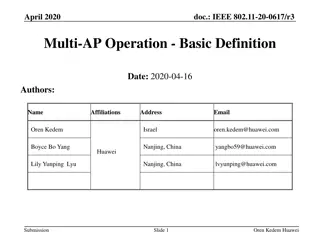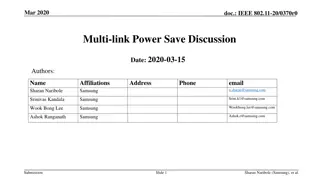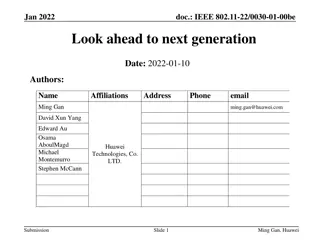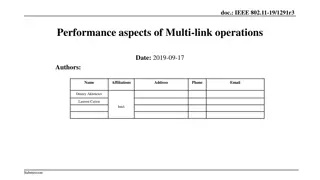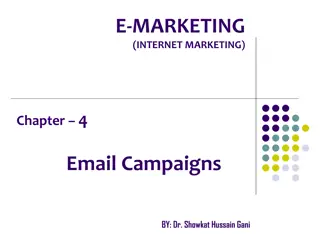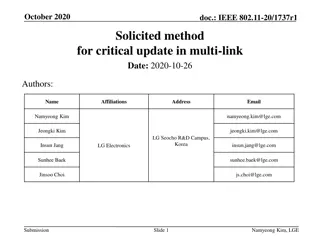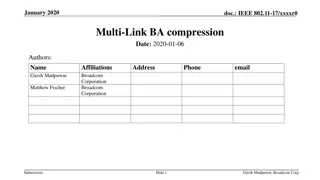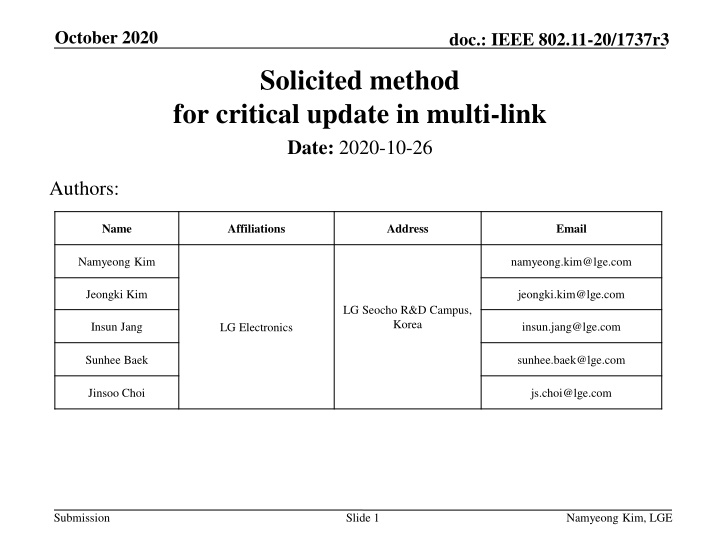
Solicited Method for Critical Update in Multi-Link Environments
Explore the proposed method for obtaining critical update information for multiple Access Points within the same network. The method involves leveraging Change Sequence fields in Beacon and Probe Response frames, enabling efficient retrieval of updated system parameters by STAs. This approach aims to streamline the process of critical updates in multi-link environments, enhancing communication efficiency and reducing power consumption for devices in various states of operation.
Uploaded on | 7 Views
Download Presentation

Please find below an Image/Link to download the presentation.
The content on the website is provided AS IS for your information and personal use only. It may not be sold, licensed, or shared on other websites without obtaining consent from the author. If you encounter any issues during the download, it is possible that the publisher has removed the file from their server.
You are allowed to download the files provided on this website for personal or commercial use, subject to the condition that they are used lawfully. All files are the property of their respective owners.
The content on the website is provided AS IS for your information and personal use only. It may not be sold, licensed, or shared on other websites without obtaining consent from the author.
E N D
Presentation Transcript
October 2020 doc.: IEEE 802.11-20/1737r3 Solicited method for critical update in multi-link Date: 2020-10-26 Authors: Name Affiliations Address Email Namyeong Kim namyeong.kim@lge.com Jeongki Kim jeongki.kim@lge.com LG Seocho R&D Campus, Korea Insun Jang insun.jang@lge.com LG Electronics Sunhee Baek sunhee.baek@lge.com Jinsoo Choi js.choi@lge.com Submission Slide 1 Namyeong Kim, LGE
October 2020 doc.: IEEE 802.11-20/1737r3 Overview Previously, we had discussed about the method for providing the Change Sequence fields for other APs. We agreed that [1] : 802.11be supports that an AP within an AP MLD shall include in the Beacon and Probe Response frames it transmits the Change Sequence fields that indicate changes of system information for other APs within the same AP MLD, where the change sequence field value for the reported AP is initialized to 0, that increments as the critical update of the reported AP is occurred. In 11be, a STA of non-AP MLD can obtain the Change Sequence number for other APs from Beacon or Probe Response frame. Submission Slide 2 Namyeong Kim, LGE
October 2020 doc.: IEEE 802.11-20/1737r3 Motivation When a STA (STA 1) of a non-AP MLD notices that the Change Sequence number for another link (AP 2) has changed, If the STA 2 of same non-AP MLD is in awake state, it can try to listen the next Beacon of another link to obtain the updated parameters. If the STA 2 of same non-AP MLD is in doze state, it needs transition to wake state to listen the next Beacon from AP 2 to obtain the updated parameters. As a result, the STA 2 shall awake to gather the updated parameters from AP2 s Beacon and this may be inefficient when the STA 2 is in doze state. Submission Slide 3 Namyeong Kim, LGE
October 2020 doc.: IEEE 802.11-20/1737r3 Recap: the method for critical update in 11ah In 11ah spec., it provides a method for the STA to retrieve the updated system information of the AP. The S1G STA shall either be awake to receive the next S1G Beacon frame that is transmitted at a TBTT or shall queue for transmission a Probe Request frame when it receives a Change Sequence field that contains a value that is different from the previously received Change Sequence field. When an S1G STA transmits a Probe Request frame to obtain the updated system information, it may include the Change Sequence element in the Probe Request frame to request a compressed Probe Response frame. When an S1G AP receives a Probe Request frame that contains a Change Sequence element from an S1G STA associated with the S1G AP, it compares the value of the received Change Sequence field with the value of its current Change Sequence field. If the value of the received Change Sequence field is not equal to the value of the current Change Sequence field, the S1G AP should send a compressed Probe Response frame, which is a Probe Response frame that includes the Change Sequence element and only the elements that need be updated by the STA. Submission Slide 4 Namyeong Kim, LGE
October 2020 doc.: IEEE 802.11-20/1737r3 Proposal 11be allows a STA of a non-AP MLD to request a part of complete information of other APs of the same AP MLD [2]. We can utilize this concept for a STA of a non-AP MLD to request only elements regarding the critical update event of other APs. We propose the solicited method to obtain critical update information for other APs of same AP MLD. In this contribution, critical update information means the elements which are classified as critical update events in 11be. We agreed that [3]: 802.11be supports that the critical updates are defined in 11.2.3.15 (TIM Broadcast) and the additional update can be added if needed. Submission Slide 5 Namyeong Kim, LGE
October 2020 doc.: IEEE 802.11-20/1737r3 Proposal: The solicited method for critical update (1/2) A STA of non-AP MLD may send an MLD probe request to obtain updated critical information of other APs. For this, we define a new subfield to indicate the request of the critical update information in ML element (i.e. Probe Request variant Multi-Link element). We call the subfield critical update request . But, the exact name is TBD. This subfield is necessary in MLD probe request variant Multi-link element. If the MLD probe request requests only critical update information of requested AP(s), the value of the subfield is set to 1. Otherwise, the value of the subfield is set to 0. The STA may include the most recently received CSN (change sequence number) information in the MLD probe request. Note: we agreed that a non-AP MLD shall maintain a record of the most recently received change sequence number for each reported APs in the AP MLD with which it has multi- link setup. Submission Slide 6 Namyeong Kim, LGE
October 2020 doc.: IEEE 802.11-20/1737r3 Proposal: The solicited method for critical update (2/2) When a STA of non-AP MLD sends an MLD probe request for critical update with the CSN information, If the AP MLD implements to support the tracking of updated elements per each CSN, the AP sends a MLD probe response including only elements that need to be updated by the STA among all critical update information. The AP can know which elements are updated comparing the current CSN of AP with the record of CSN of STA received based on the tracking record of updated element(s) per each CSN. If the AP MLD does not implement to support the tracking of updated elements per each CSN, the AP sends a MLD probe response including all critical update information. Note: The all critical update information is not complete profile it means only the elements that qualified as critical update. The critical update information is defined in 11.2.3.15 of 802.11 baseline spec. (See the Appendix in Slide 19). When a STA of non-AP MLD sends an MLD probe request for critical update without the CSN information, On receiving the MLD probe request without the CSN of the STA(s), an AP of AP MLD sends an MLD probe response including all critical update information. Submission Slide 7 Namyeong Kim, LGE
October 2020 doc.: IEEE 802.11-20/1737r3 Signaling for CSN information (1/4) We have two options to provide CSN information of the requesting STA. Option 1: Use of Change Sequence element Option 2: Use of Change Sequence field with a control field Submission Slide 8 Namyeong Kim, LGE
October 2020 doc.: IEEE 802.11-20/1737r3 Signaling for CSN information (2/4) - Option 1: Use of Change sequence element We can borrow a concept of existing Change Sequence element to provide the CSN information of requesting STA for the corresponding AP. A STA may request critical update information of other APs by sending a MLD probe request including a Change Sequence element. In this case, the Critical update request subfield shall be set to 1. MLD probe request Submission Slide 9 Namyeong Kim, LGE
October 2020 doc.: IEEE 802.11-20/1737r3 Signaling for CSN information (3/4) - Option 2: Use of Change Sequence field with a control field We can use a Change Sequence field to provide the CSN information of requesting STA for the corresponding AP. For this, we also define a new subfield to indicate the presence of the Change Sequence field in ML element (i.e. Probe Request variant Multi-Link element). We call the subfield CSN Presence . But, the exact name is TBD. If the value of the subfield is set to 1, it means the CSN field is present in Per-STA Control of Per-STA profile (x). Otherwise, it means the CSN field is absent. A STA may request critical update information of other APs by sending a request message including a Change Sequence field. In this case, the Critical update request and the CSN presence subfield shall be set to 1. MLD probe request Submission Slide 10 Namyeong Kim, LGE
October 2020 doc.: IEEE 802.11-20/1737r3 Signaling for CSN information (4/4) - Pros & Cons Option 1 This option is simple using existing Change Sequence element. We don t need to define a new subfield or element. But, the overhead for default field (e.g. element ID, length field) may occur each Per-STA Profile. When the STA requests information on multiple APs, this overhead may increase further. Option 2 This option requires a new subfield. However, the new subfield is just 1bit (e.g. CSN Presence field) But, the overhead for default field can be reduced by using the change sequence field (not element). Submission Slide 11 Namyeong Kim, LGE
October 2020 doc.: IEEE 802.11-20/1737r3 Conclusion We propose the solicited method to retrieve the critical update information for one or more AP(s). Using this method, a STA may obtain only elements that classified as critical update events in 11be of other APs. The STA may include the most recently received CSN (change sequence number) information in the MLD probe request. To support this method, we propose a new Critical update request subfield to indicate the request of critical update information in Multi- link IE. When a STA requests the critical update information, the value of the subfield shall set to 1. We provide 2 options to provide CSN information of requesting STA, in MLD probe request. We can use the Change sequence element (option 1) or the Change sequence field (option 2) for this. Submission Slide 12 Namyeong Kim, LGE
October 2020 doc.: IEEE 802.11-20/1737r3 References [1] 11-20/0586: MLO Signaling of critical updates (Abhishek Patil, Qualcomm) [2] 11-20/0411: MLO Information exchange for Link switching (Namyeong Kim, LG Electronics) [3] 11-20/0337: Multi-link BSS Parameter Update (Yongho Seok, MediaTek) Submission Slide 13 Namyeong Kim, LGE
October 2020 doc.: IEEE 802.11-20/1737r3 SP #1 Do you agree to add the following to 11be SFD: A STA of a non-AP MLD may send a Probe Request frame to the peer AP to obtain critical update information of another AP of the AP MLD with which the non-AP MLD has setup. The Probe Request frame is MLD probe request. Note: the critical update information means the elements which are classified as critical update events in 11be. Submission Slide 14 Namyeong Kim, LGE
October 2020 doc.: IEEE 802.11-20/1737r3 SP #2 Do you agree to include a subfield in Per-STA Control field of Per- STA Profile in Probe Request variant Multi-Link element to indicate the request of elements that classified as critical update events in 11be? For example, the name of the subfield is critical update request . The exact name is TBD. When a STA of a non-AP MLD sends a MLD probe request for critical update information, the critical update request subfield shall be set to 1. Submission Slide 15 Namyeong Kim, LGE
October 2020 doc.: IEEE 802.11-20/1737r3 SP #3 Do you agree to add the following to 11be SFD: When a STA of a non-AP MLD sends a MLD probe request to the peer AP to obtain critical update information of another AP of the AP MLD with which the non-AP MLD has setup, it may include the value of the most recently received change sequence number of the another AP in the MLD probe request. Note: the critical update information means the elements which are classified as critical update events in 11be. Submission Slide 16 Namyeong Kim, LGE
October 2020 doc.: IEEE 802.11-20/1737r3 SP #4 Which option do you prefer as a signaling to provide the CSN information of requesting STA which requests critical update information of other APs? Option 1: Use Change Sequence element Option 2: Use of Change Sequence field with a control field Abstain Submission Slide 17 Namyeong Kim, LGE
October 2020 doc.: IEEE 802.11-20/1737r3 Appendix: Critical update information In 11.2.3.15 of 802.11 baseline spec., The following events shall classify as a critical update: A. Inclusion of a Channel Switch Announcement element B. Inclusion of an Extended Channel Switch Announcement element C. Modification of the EDCA parameters element D. Inclusion of a Quiet element E. Modification of the DSSS Parameter Set(#4315) F. Modification of the HT Operation element G. Inclusion of a Wide Bandwidth Channel Switch element H. Inclusion of a Channel Switch Wrapper element I. Inclusion of an Operating Mode Notification element J. Inclusion of a Quiet Channel element K. Modification of the VHT Operation element An AP may classify other changes in the Beacon frame as critical updates. Submission Slide 18 Namyeong Kim, LGE

